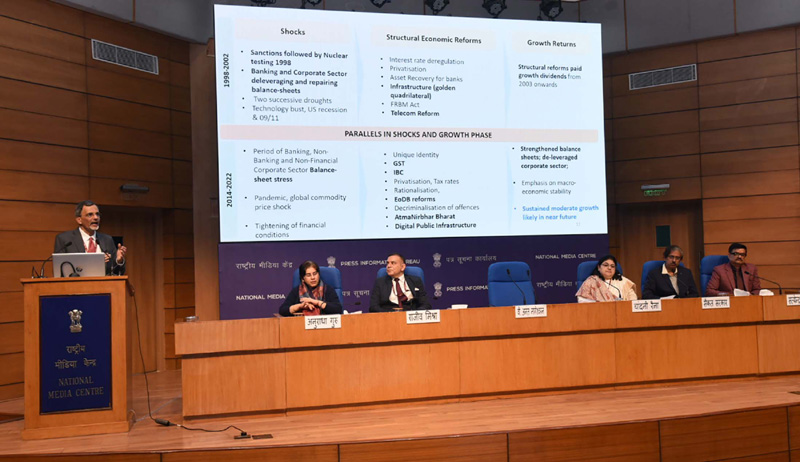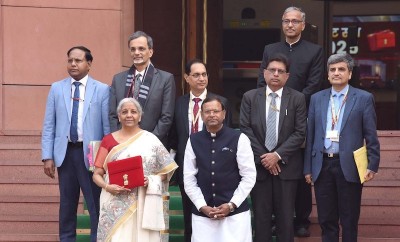 Economic Survey
Economic Survey
Unemployment rates fall from 5.8 pct in 2018-19 to 4.2 pct in 2020-21: Economic Survey
New Delhi: The Economic Survey 2022-23 tabled by the Minister of Finance and Corporate Affairs, Nirmala Sitharaman in Parliament, on Tuesday states that while the pandemic impacted both labour markets, and employment ratios, now with sustained effort in the last few years, coupled with quick response after the pandemic, and the world’s largest vaccination drive being undertaken in India, labour markets have recovered beyond pre-Covid levels, in both urban and rural areas, as observed in supply-side and demand-side employment data.
In 2019 and 2020, 29 Central Labour Laws were amalgamated, rationalised, and simplified into four Labour Codes, viz., the Code on Wages, 2019 (August 2019), the Industrial Relations Code, 2020, the Code on Social Security, 2020, and the Occupational Safety, Health & Working Conditions Code, 2020 (September 2020).According to the survey, rules made under the Codes have been entrusted to Central Government, State Government and at the appropriate level. As of 13 December 2022, 31 States also have pre published the draft rules under the Code on Wages, 28 States under Industrial Relations Code, 28 States under Code on Social Security, and 26 States under Occupational Safety Health and Working Conditions Code.Labour markets have recovered beyond pre-Covid levels, in both urban and rural areas, with unemployment rates falling from 5.8 per cent in 2018-19 to 4.2 per cent in 2020-21.
As per Usual Status in Periodic Labour Force Survey(PLFS), the Labour Force Participation Rate (LFPR), Worker Population Ratio (WPR) and unemployment rate (UR) in PLFS 2020-21(July-June) have improved for both males and females in both rural and urban areas compared to PLFS 2019-20 and 2018-19.The Labour Force Participation Rate for males has gone up to 57.5% in 2020-21, as compared to 55.6% in 2018-19.
Female Labour Force Participation Rate has gone up to 25.1% in 2020-21 from 18.6% in 2018-19. There is a notable rise in Rural Female Labour Force Participation Rate from 19.7 % in 2018-19 to 27.7% in 2020-21.According to broad status in employment, the share of self-employed increased and that of regular wage/salaried workers declined in 2020-21 vis-à-vis 2019-20, driven by trend in both rural and urban areas.
The share of casual labour declined slightly, driven by rural areas. As per the Economic Survey, based on the industry of work, the share of workers engaged in agriculture rose marginally from 45.6 per cent in 2019-20 to 46.5 per cent in 2020-21, the share of manufacturing declined faintly from 11.2 per cent to 10.9 per cent, the share of construction increased from 11.6 per cent to 12.1 per cent, and share of trade, hotel & restaurants declined from 13.2 per cent to 12.2 per cent, over the same period.The Economic Survey highlights measurement issues in calculating Female Labour Force Participation Rate.
The common narrative of Indian women’s low LFPR misses the reality of working females integral to the economy of the household and the country. Measurement of employment through the survey design and content can make a significant difference to final LFPR estimates, and this matters more for measuring female LFPR than male LFPR.
The survey states that there is a need to broaden the horizon of measuring work, which constitutes the whole universe of productive activities alongside employment, especially for women. According to the latest ILO standards, limiting productive work to labour force participation is narrow and only measures work as a market product. It does not include the value of women’s unpaid domestic work, which can be seen as expenditure-saving work such as collecting firewood, cooking, tutoring children, etc, and contributes significantly to the household’s standard of living.
The Survey recommends that a wholesome measurement of “work” may require improved quantification through redesigned surveys. That said, there is further significant scope to nullify the gender-based disadvantages to enable free choice of women to join the labour market. Ecosystem services, including affordable creches, career counselling/handholding, lodging and transportation, etc., can further help unlock the gender dividend for inclusive and broad-based growth.The PLFS conducted by the MoSPI at a quarterly level for urban areas is available till July-September 2022.
The data shows an improvement in all the key labour market indicators in the quarter ending September 2022 both sequentially and over the last year, as per the Current Weekly Status. The labour participation rate increased to 47.9 per cent in July-September 2022 from 46.9 per cent a year ago, while the worker-population ratio strengthened from 42.3 per cent to 44.5 per cent in the same period.This trend highlights that the labour markets have recovered from the Covid impact.
The QES, conducted by the Labour Bureau, covers establishments with ten or more workers in nine major sectors viz. manufacturing, construction, trade, transport, education, health, accommodation & restaurants, IT/BPOs, and financial services. So far, results of four rounds of the QES have been released, covering four quarters of FY22.
The estimated total employment in the nine selected sectors according to the fourth round of QES (January to March 2022) stood at 3.2 crore, which is nearly ten lakh higher than the estimated employment from the first round of QES (April-June 2021).
The increase in estimates of workers from Q1FY22 to Q4FY22 was driven by rising employment in sectors such as IT/BPO (by 17.6 lakh), health (7.8 lakh), and education (1.7 lakh), due to rising digitisation and resurgence of services sector economy.
Regarding terms of employment, regular employees constituted the majority of workers across sectors, with a share of 86.4 per cent in the total workforce in Q4FY22. Further, out of the total employed in the fourth round of QES, 98.0 per cent are employees while 1.9 per cent are self-employed. Gender-wise, 31.8 per cent of the total estimated employed are women and 68.2 per cent are men. In the sectors covered, manufacturing employs the highest number of workers.
As per the latest ASI FY20, employment in the organised manufacturing sector has maintained a steady upward trend over time, with the employment per factory increasing gradually. In terms of share of employment (total persons engaged), the food products industry (11.1 per cent) remained the largest employer, followed by wearing apparel (7.6 per cent), basic metals (7.3 per cent), and motor vehicles, trailers, and semi-trailers (6.5 per cent). State-wise, Tamil Nadu had the largest number of persons engaged in factories (26.6 lakh), followed by Gujarat (20.7 lakh), Maharashtra (20.4 lakh), Uttar Pradesh (11.3 lakh), and Karnataka (10.8 lakh).
Over time, there is a visible trend towards bigger factories employing more than 100 workers, their numbers rising by 12.7 per cent from FY17 to FY20, compared to a broadly constant number of smaller factories. Between FY17 and FY20, total persons engaged in larger factories rose by 13.7 per cent, compared to 4.6 per cent in smaller factories.
Resultantly, the share of larger factories in the total number of factories has increased from 18 per cent in FY17 to 19.8 per cent in FY20, and their share in total persons engaged shows a similar expansion from 75.8 per cent in FY17 to 77.3 per cent in FY20. Thus, in terms of total persons engaged, employment has been rising in larger factories (employing more than 100 workers) than in smaller ones, suggesting scaling up of manufacturing units.
Employment generation coupled with improving employability is the priority of the Government.
The net addition in EPF subscriptions during FY22 was 58.7 per cent higher than in FY21 and 55.7 per cent higher than that in the pre-pandemic year 2019. In FY23, net average monthly subscribers added under EPFO increased from 8.8 lakh in April-November 2021 to 13.2 lakh in April-November 2022.
The swift rebound of formal sector payroll addition can be attributed to the Aatmanirbhar Bharat Rojgar Yojana (ABRY), launched in October 2020 to boost the economy, increase the employment generation in post Covid-19 recovery phase, and to incentivise creation of new employment along with social security benefits and restoration of employment lost during the pandemic.
Ministry of Labour and Employment (MoLE) has developed E-Shram portal for creating a National database of unorganised workers, which is verified with Aadhaar.
It captures details of workers like name, occupation, address, occupation type, educational qualification, and skill types etc., for the optimum realisation of their employability and extend the benefits of the social security schemes to them.
It is the first-ever national database of unorganised workers, including migrant workers, construction workers, gig and platform workers, etc. Currently, E-Shram portal has been linked to NCS portal and ASEEM portal for seamless facilitation of services.As on 31 December 2022, total over 28.5 crore unorganised workers have been registered on E-Shram portal. Female registrations stood at 52.8 per cent of the total and 61.7 per cent of total registrations belonged to the age group 18-40 years.
State-wise, Uttar Pradesh (29.1 per cent), Bihar (10.0 per cent), and West Bengal (9.0 per cent) accounted for nearly half of total registrations. Agriculture sector workers contributed to 52.4 per cent of the total registrations, followed by domestic and household workers (9.8 per cent), and construction workers (9.1 per cent).
Support Our Journalism
We cannot do without you.. your contribution supports unbiased journalism
IBNS is not driven by any ism- not wokeism, not racism, not skewed secularism, not hyper right-wing or left liberal ideals, nor by any hardline religious beliefs or hyper nationalism. We want to serve you good old objective news, as they are. We do not judge or preach. We let people decide for themselves. We only try to present factual and well-sourced news.







